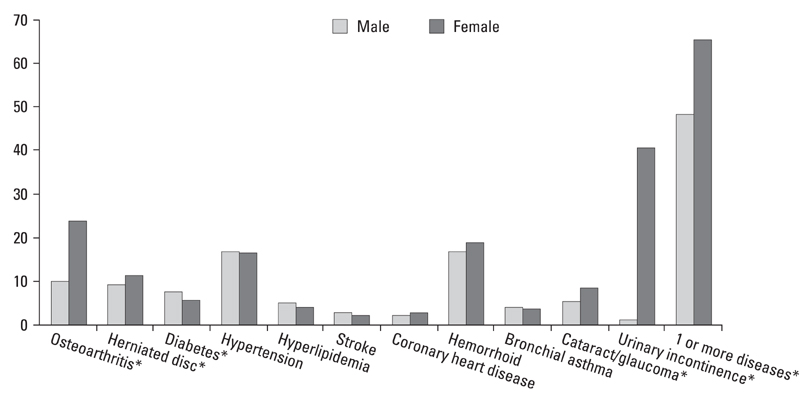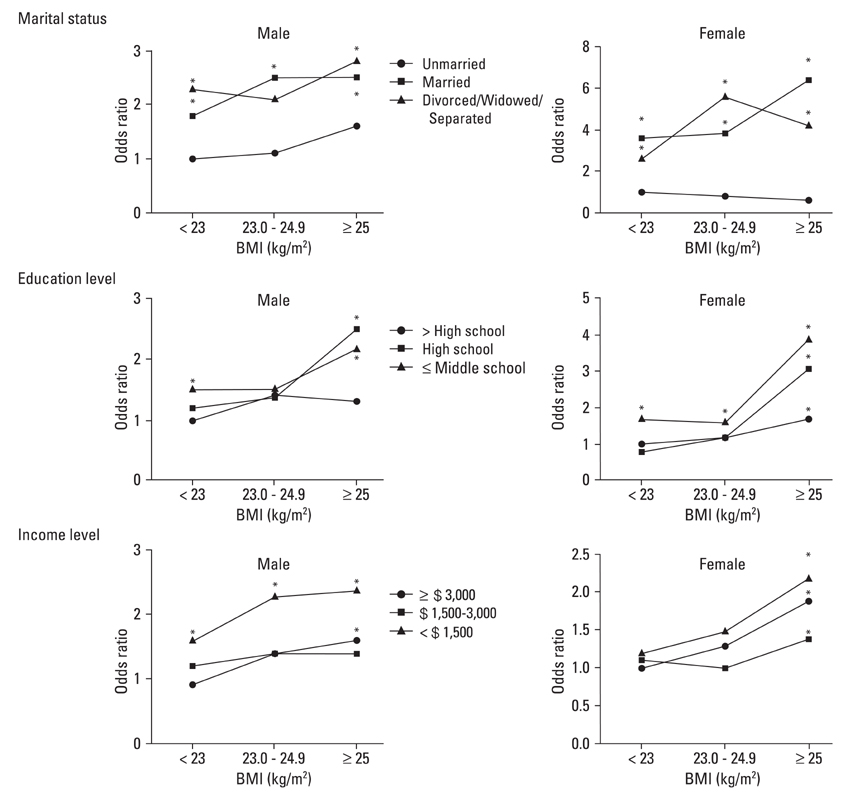Yonsei Med J.
2010 Mar;51(2):171-177. 10.3349/ymj.2010.51.2.171.
Sociodemographic Status and Self-Reported BMI-related Morbidity in Koreans
- Affiliations
-
- 1Department of Family Medicine, Pusan Paik Hospital, Inje University College of Medicine, Busan, Korea. fmlky@inje.ac.kr
- KMID: 1126014
- DOI: http://doi.org/10.3349/ymj.2010.51.2.171
Abstract
-
PURPOSE: This study examined whether the relationship between body mass index (BMI) and the morbidity of chronic diseases differs by marital status, education, and income level.
MATERIALS AND METHODS
From a nationally representative sample of 5,526 adults from the third Korean National Health and Nutrition Examination Survey (2005), data regarding measured height and weight to classify BMI category (< 23, 23-24.9, > or = 25), self-reported sociodemographics (marital status, education, income, age, sex, and residence area), health behaviors (smoking, alcohol use, exercise, sleep, stress perception, and depression), and morbidity from at least one chronic disease were collected.
RESULTS
Education, income, and marital status were significantly associated with morbidity regardless of adjustment for BMI and health behaviors. After adjusting for BMI, other sociodemographic factors, and health behaviors, the odds ratio (95% confidence interval) of morbidity was 2.9 (2.4-3.7) for those in the married group and 2.9 (2.1-4.0) for those in the separated/divorced/widowed group, 2.0 (1.6-2.5) for those in the lowest education group, and 1.3 (1.2-1.6) for those in the lowest income group. When the BMI category and sociodemographic factors were combined, the odds ratios were elevated for those in the combination group with higher BMI and lower sociodemographic position.
CONCLUSION
Korean subjects who were married, in the lowest education group, or in the lowest income level had a higher risk of morbidity in relation to BMI.
Keyword
MeSH Terms
Figure
Reference
-
1. Pi-Sunyer FX. The obesity epidemic: pathophysiology and consequences of obesity. Obes Res. 2002. 10:Suppl 2. 97S–104S.
Article2. Syme SL, Berkman LF. Social class, susceptibility and sickness. Am J Epidemiol. 1976. 104:1–8.
Article3. Chandola T, Jenkinson C. The new UK National Statistics Socio-Economic Classification (NS-SEC); investigating social class differences in self-reported health status. J Public Health Med. 2000. 22:182–190.4. Schnohr C, Højbjerre L, Riegels M, Ledet L, Larsen T, Schultz-Larsen K, et al. Does educational level influence the effects of smoking, alcohol, physical activity, and obesity on mortality? A prospective population study. Scand J Public Health. 2004. 32:250–256.5. Lantz PM, House JS, Lepkowski JM, Williams DR, Mero RP, Chen J. Socioeconomic factors, health behaviors, and mortality: results from a nationally representative prospective study of US adults. JAMA. 1998. 279:1703–1708.6. Asthana S, Gibson A, Moon G, Brigham P, Dicker J. The demographic and social class basis of inequality in self reported morbidity: an exploration using the Health Survey for England. J Epidemiol Community Health. 2004. 58:303–307.7. Mackenbach JP, Stirbu I, Roskam AJ, Schaap MM, Menvielle G, Leinsalu M, et al. Socioeconomic inequalities in health in 22 European countries. N Engl J Med. 2008. 358:2468–2481.8. Kiecolt-Glaser JK, Newton TL. Marriage and health: his and hers. Psychol Bull. 2001. 127:472–503.9. Robles TF, Kiecolt-Glaser JK. The physiology of marriage: pathways to health. Physiol Behav. 2003. 79:409–416.10. Molarius A, Seidell JC, Sans S, Tuomilehto H, Kuulasmaa K. Educational level, relative body weight, and changes in their association over 10 years: an international perspective from the WHO MONICA Project. Am J Public Health. 2000. 90:1260–1268.11. The third Korea National Health and Nutrition Examination Survey (KNHANES III), 2005. 2006. Ministry of Health and Welfare.12. WHO Expert Consultation. Appropriate body-mass index for Asian populations and its implications for policy and intervention strategies. Lancet. 2004. 363:157–163.13. Christiansen T, Kooiker S. Inequalities in health: evidence from Denmark of the interaction of circumstances and health-related behavior. Scand J Public Health. 1999. 27:181–188.
Article14. Cohen S, Janicki-Deverts D, Miller GE. Psychological stress and disease. JAMA. 2007. 298:1685–1687.15. Stecker T, Fortney JC, Steffick DE, Prajapati S. The triple threat for chronic disease: obesity, race, and depression. Psychosomatics. 2006. 47:513–518.16. Dong C, Sanchez LE, Price RA. Relationship of obesity to depression: a family-based study. Int J Obes Relat Metab Disord. 2004. 28:790–795.17. Strine TW, Chapman DP, Balluz LS, Moriarty DG, Mokdad AH. The associations between life satisfaction and health-related quality of life, chronic illness, and health behaviors among U.S. community-dwelling adults. J Community Health. 2008. 33:40–50.18. Ordovas JM. Gender, a significant factor in the cross talk between genes, environment, and health. Gend Med. 2007. 4:Suppl B. S111–S122.19. Newell SA, Girgis A, Sanson-Fisher RW, Savolainen NJ. The accuracy of self-reported health behaviors and risk factors relating to cancer and cardiovascular disease in the general population: a critical review. Am J Prev Med. 1999. 17:211–229.
- Full Text Links
- Actions
-
Cited
- CITED
-
- Close
- Share
- Similar articles
-
- Nutrition and food intake status among adults in Jeju according to sociodemographic characteristics and obesity
- Measuring BMI Cutoff Points of Korean Adults Using Morbidity of BMI-related Diseases
- Correlations Among Body Weight, Life - Style and Health Status in Korean Adults
- Sociodemographic Factors Associated with Nutrients Intake of Elderly in Korea
- Sociodemographic Characteristics of Underweight Korean Adults: Korea National Health and Nutrition Examination Survey, 2007-2010



